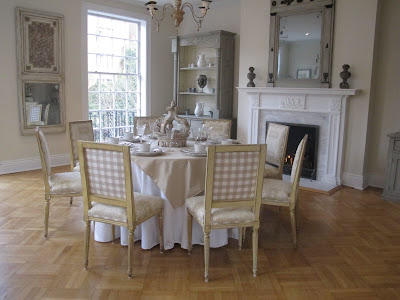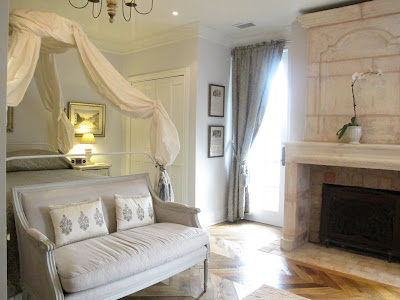By Beth Herman

When it comes to families, no one wants a home's manicured front lawn and curb appeal marred by remnants of yesterday's water balloon fight or Saturday's mud pie bake-off. In that respect, relegating the family experience to the back yard is a pretty good idea.

For
FOX Architects Principal Jim Allegro and designer
Holly Martin, creating both a formal and informal environment for 120
Graduate Management Admission Council (GMAC) employees, 11921 Freedom Drive in Reston, Va., was indeed predicated on an expanded front yard/back yard concept, with high functioning public and private spaces that reflected the company's work and play ethic paramount.
With employee longevity a hallmark of GMAC, the nonprofit organization was incepted in 1954 as a comprehensive resource to meet the needs of business schools and students. Turning a 45,000 s.f. space into a design that reflected a warm employee family culture, along with areas that spoke to GMAC’s longstanding authority in its field, was a challenge met head-on by Allegro and Martin with their own designs on work and play.
A Fountain Runs Through It
Relocating from Tyson’s Corner to Reston, among GMAC’s primary goals was to improve employee quality of life. With a town center environment (ice skating rink; fountains; shops; restaurants and other amenities - all within walking distance) and abbreviated commute for reduced carbon footprint in the cards for much of its staff, the company jettisoned a 45,000 s.f. facility on two floors in Tyson’s Corner for one of equal size, also on two floors, in Reston.
Speaking to the collaboration between architects and client, Buck Blackburn, GMAC associate director, facilities and office services, said, “They became partners in the process...FOX had in-depth interviews with all departments and made sure to incorporate those requests into their design. They worked closely and smartly with all levels of the organization.”

Allowing that GMAC’s previous space was in fact not outdated or cramped in any way, but “equally modern,” according to Allegro, among the issues FOX Architects faced was ensuring the new space emulated the old but with more style, creativity and advanced technology. With challenges that included lower ceiling height and an exchange of formerly panoramic views for those of surrounding buildings, opening the space and cultivating natural light along the perimeter were intrinsic to the organization’s new design. A focus on state-of-the-art A/V technology and video conferencing, which would minimize extensive travel requirements at issue for some employees, was also a new design objective.
Focus and Balance
“I’d say there was an element of public and private that played into the design concept,” Allegro said, explaining the “front yard” experience was to represent the former and “back yard” the latter. “They don’t get lots of visitors that come beyond their reception area and meeting space, and that’s where the bulk of their traffic is captured,” he said, adding the dollar and design focus went into feature walls in that space with curved, textured plaster and stone flooring.
Opposite a white lacquer, maple and antique glass reception desk, on the other side of the lobby where a bank of five elevators delivers visitors to the floor, Martin chose a double-sided fireplace that bespoke dignity and formality, yet accorded warmth to a space that in many offices can simply be sparse and utilitarian. A graceful, two-story water wall with rock garden base lends a regal, resort-like feel to the lobby area as well.

Because the reception area connects GMAC’s two floors (floors three and four of the building), Allegro said they elected to retain a stairway already in place. “That stair links very active places,” he said, adding “there’s nothing worse than a monumental stair that never gets used.” In this respect, the architect analogized that “…it feels more familial - like kids running up and down, going from bedrooms to kitchen,” noting the reason for the stairs is that they link 4th floor conference rooms to the highly trafficked reception area below, which also includes a lunchroom and smaller meeting rooms. In the lunchroom, a variety of seating, including touches like mesh “Fit” chairs from Interstuhl that conform to the body and breathe to accommodate body temperature, encourage staff to bring their laptops for a change of atmosphere, or even engage in a variety of Wii games which are readily available. A furnished balcony that overlooks Reston Town Center and supports about 200 people accommodates office and family functions, including holiday gatherings where children can watch the skaters below.
Where the floor above is largely

dedicated to training, meetings and conferences, “mini team rooms” for more casual meetings, replete with lounge furniture, exist on both floors for staff purposes. Utilizing Plynyl (woven vinyl fabric bonded to polyurethane cushion) flooring, which is more durable and playroom-like, adds a true “back yard” quality to the mini team rooms which feature TV monitors. Coffee/copy functions nearby facilitate other needs.
According to Blackburn, the previous tenant in the space “…had dark wood and the window line covered with offices.” With a 60/40 closed office vs. open space concept now, access to the perimeter window line is generous. Where offices – which average 140 s.f – are enclosed, clear glass fronts channel natural light. Also, Martin’s light-toned wood, khaki-colored accent walls and white back-painted glass suggest an atmosphere of great balance, the overall design and color palette perpetuating the soothing, spa-like atmosphere first suggested by the lobby’s two-story water feature.
Top of the World
In their former offices, though conference and training rooms were cleverly named for various countries, they were inadequate spaces and Blackburn recalled using hotels for “all hands” meetings, at added cost to the company.
Creating a 2,200 s.f. divisible conference/training room that accommodates 150 in Reston, made up of one large and two smaller rooms, the space was subsequently monikered “the world,” Martin explained, and boasts Skyfold doors that retract into the ceiling for ultimate use of the space. Nine panels, or plasma screens, punctuate one wall, with access to d

aylight made possible by relocating a mobile wall. Tables on wheels result in unlimited configurations of space. A boardroom has a video wall which is eight feet long and 40 inches high, linking GMAC to various entities and serving to cut down on prolific travel, increase family time and reduce carbon footprint.
“My office is near the lobby and I hear visitor after visitor marvel at how nice the new office is,” Blackburn said, adding he hears staff interacting with visitors about how happy they are to work there. Noting he also gets to interact more with employees and they with each other, Blackburn affirmed, “It will take a few years to discover all the ways to make use of this space.”
Washington D.C. design news
 For those in the market for a wildly grand home in DC, 1824 R Street, NW, is for sale for an
For those in the market for a wildly grand home in DC, 1824 R Street, NW, is for sale for an  asking price of $15,500,000. The Georgian mansion was the former Embassy of Singapore until seven years ago, when it was fully restored.
Jim Bell, real estate agent for Washington Fine Properties notes how difficult it is to find this much space (13,000 s.f.) in a downtown residential property, though the building, likely built in the 1800's (the courthouse that stored the papers apparently burned down, so it's not entirely clear what year the home was built), is zoned for multi-purpose use. The space had been renovated by the son of the most recent owner, a doctor with a passion for architecture and design. The dwelling is being marketed as an embassy-turned-residence, a "single family home for the past 7 years," but DC residents know that it was the short-lived Artists Residents Inn.
What's so great about the home? For starters, large windows facing south and west exposure allow plenty of light, or in realtorspeak, "a magical glow."
asking price of $15,500,000. The Georgian mansion was the former Embassy of Singapore until seven years ago, when it was fully restored.
Jim Bell, real estate agent for Washington Fine Properties notes how difficult it is to find this much space (13,000 s.f.) in a downtown residential property, though the building, likely built in the 1800's (the courthouse that stored the papers apparently burned down, so it's not entirely clear what year the home was built), is zoned for multi-purpose use. The space had been renovated by the son of the most recent owner, a doctor with a passion for architecture and design. The dwelling is being marketed as an embassy-turned-residence, a "single family home for the past 7 years," but DC residents know that it was the short-lived Artists Residents Inn.
What's so great about the home? For starters, large windows facing south and west exposure allow plenty of light, or in realtorspeak, "a magical glow."
 Let's talk numbers:
Let's talk numbers: The half bathroom on the first floor is hidden by a swinging bookshelf.
The half bathroom on the first floor is hidden by a swinging bookshelf.  Master bedroom, part of master suite
Master bedroom, part of master suite


















































.jpg)



